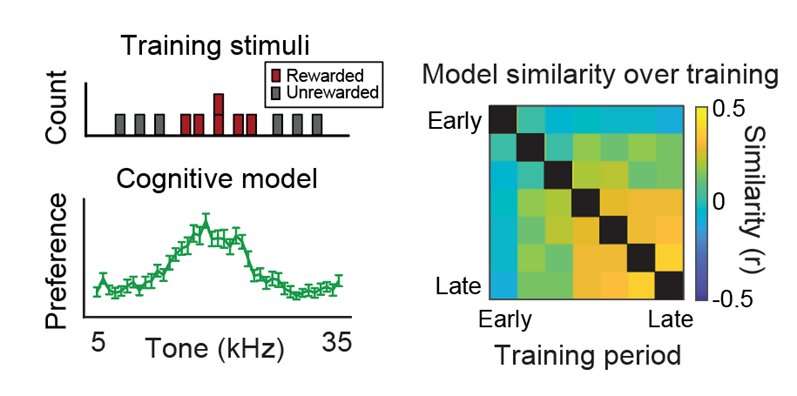July 22, 2023 feature
This article has been reviewed according to Science X's editorial process and policies. Editors have highlighted the following attributes while ensuring the content's credibility:
fact-checked
peer-reviewed publication
trusted source
proofread
Study explores the emergence of predictive models in the hippocampus

Neuroscience studies have found that the brain spontaneously organizes events and life experiences into memories, which can be mentally retrieved and replayed at different points in time. These memories of past events are known to partly shape human perceptions and behavior, for instance highlighting strategies for solving a given problem that have proved to be effective in the past.
A key region of the hippocampus, known as the CA1 region, has been hypothesized to support the human ability to retrieve relevant memories to forecast future outcomes, by creating predictive models that roughly represent what could happen in different scenarios. While many neuroscientists have been investigating this hypothesis, the ways in which these models are established and updated over time remain poorly understood.
Researchers at The Hospital for Sick Children in Toronto and University of Toronto recently carried out a study aimed at better understanding the formation of these predictive models in the hippocampus CA1 region. Their findings, published in Neuron, reveal the activity of CA1 neurons in the mouse brain as they are learning to complete a task by making predictions based on their previous experiences.
"When we think about memory, we often might think of it as a way to recall our past experiences—a sort of 'reminiscing device,'" Paul Frankland, one of the researchers who carried out the study, told Medical Xpress. "But another way to look at memory is in thinking how it can be used to predict the future. This is the question we explored in our study, where we asked: how do our past experiences allow us to better anticipate what the future holds?"
As part of their experiment, Frankland and his colleagues trained 80 mice to complete puzzles that involved telling different sounds apart to get a food reward. The puzzles they solved followed a similar general rule, which allowed the mice to mentally predict what might happen if they behaved in specific ways.
The researchers found that over time, the mice did not only learn to solve individual problems, but also learned the rule underlying all the puzzles. Ultimately, they were able to apply this rule to future trials, effectively solving new puzzles that they did not encounter before.
"As we were training the mice and observing them, we also imaged neural activity in the hippocampus—an area of the brain that is important for solving these types of puzzles," Frankland explained. "Remarkably, as soon as the mice 'got it'—that is, learned the rule—we noticed that their neural activity patterns settled into a reliable state. We think that it is this state that corresponds to the predictive model—a state that allows the mice to make predictions of novel, future events based on their past experience."
Overall, the findings gathered by this team of researchers confirm that the CA1 region of the hippocampus supports the development of predictive models, by combining memories of past events with new sensory information. In the future, their work could pave the way for further studies focusing on this brain region, which could further elucidate the ways in which the brain utilizes memories to guide future behavior.
"Our study shifts the focus of memory research from thinking about how memory is useful for thinking about the past to how it is important for making predictions about the present or future," Frankland added. "We are interested in what kinds of things affect the how efficiently predictive models form in the hippocampus. Maybe stress disrupts the formation of these models, or perhaps these sorts of models form more readily in early development—in younger brains that have less experience of the world and need to quickly form models about how the world works."
More information: Adam M.P. Miller et al, Emergence of a predictive model in the hippocampus, Neuron (2023). DOI: 10.1016/j.neuron.2023.03.011
© 2023 Science X Network





















